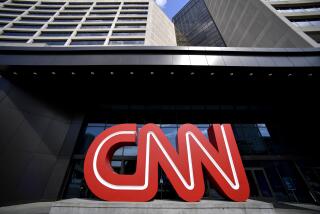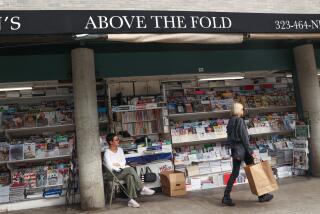On the Media: ‘Old media’s’ dilemma of charging for online content
- Share via
Fred from high school e-mailed this week out of the blue, wondering why the “old media” sources he depends on don’t stop carping about their economic problems and do something.
“When are the print media going to join forces to solve their problems?” Fred asked. He said he would even pay $30 a month to read his favorite news outlets online, money he hopes would keep serious reporting from going away. Just don’t bog down Fred with multiple registrations and billing plans.
Many more people scoff at the mere notion they would cough up their credit card number for something the Internet has been delivering to them for free for more than a decade. They vow to skirt any “pay wall” that stands in their way.
What has been mostly an academic debate will finally emerge as a real-world trial in the coming months, with giant News Corp. pushing several of its newspapers worldwide into the pay-to-view camp, the New York Times soon to follow and a menagerie of smaller newspapers tentatively tilting in that direction.
The bad news is that Fred’s pay-once, read-everywhere reality doesn’t appear to be on the near horizon. The good news is that technology enables it, if newspapers would just get onboard. To do that, publishers want to be assured they don’t run afoul of anti-trust laws that could punish them from banding together as a consortium. They also have to throw off the fear of what might go wrong and experiment. Sitting still isn’t making matters any better.
Newspapers arrive in this challenging place because publishers feel like they’re running out of other options. Pumping out professional reporting, photography, writing and editing requires monster energy. It can’t be sustained (with any breadth or depth, anyway) on a diet of notoriously dollar-lite Web advertising. With their free websites, meanwhile, newspapers push battalions of readers away from their own print editions, which still bring in the lion’s share of the cash.
But asking for money for something that has been free will be a tall task. As the payment systems go into place, news outlets will get a hard lesson on what stories and kinds of coverage the public is still willing to pay for.
The best results, so far, have been produced by the financial papers. Rupert Murdoch considered dropping payments when his News Corp. took over the Wall Street Journal, with thoughts of expanding readership and therefore ad revenue. But he quickly reversed when he learned the manifold increases in Web traffic and advertising it would take to replace online subscription revenue, now estimated at roughly $65 million each year.
The Financial Times has seen its revenue online grow 48% this year over the year before. Since just the start of the year, FT.com reported the number of subscriptions (standard price, $221 a year) jumped 50% to 189,000. To put that in perspective, 390,200 people subscribe to the print product, which costs about $350 a year.
The best of the financial press has succeeded by keeping staffing and quality high. They offer a product viewed as essential by business people — who often pay for their subscriptions as a business expense.
Other forays into the paid-Web frontier have been more mixed. When News Corp. cut off content from its Times of London and Sunday Times four months ago, the audience to its websites plunged by two-thirds, to about 2.4 million. At the same time, the papers added about 105,000 paid customers online, about half via monthly subscriptions, the rest pay-as-they-read.
The tech site Gigacom judged the London papers’ trade-off — fewer customers but more paying ones — as an obvious loser. “The newspapers have been cut off from the news flow on the broader Internet, and the potential benefits of attracting links and commentary from other sites that could help to promote their content,” it judged. “Not a great trade, no matter how you slice it.”
TechCrunch also wondered whether the trade-off made sense in the long run, but said for now News Corp. had come out ahead. The tech site guesstimated new online subscription revenues for the London papers of about $9.6 million a year, projecting that was several times more than the ad revenue declines because of lower readership.
Newspaper analyst Alan Mutter, who has served as a consultant to the L.A. Times and many other papers, urged newspapers to throw off their fear of collaboration and experimentation to join in a uniform pay system. He invoked Benjamin Franklin, “If we don’t hang together, we most assuredly will all hang separately.”
Mutter, the former newspaper editor, said papers instead have launched “a scattered number of half-baked, one-off pay schemes that for the most part are doomed to fail.” Without a uniform approach, he said, the vast number of users who search the Internet to find topics would constantly be bombarded with new pay and registration requirements.
Mutter’s based his analysis largely on his failed attempt to rally an alliance of papers to buy into “a widely available, highly visible system that surfers would recognize all over the Web.” He said this week he still sees “a complete lack of conviction about what will work” and a fear of turning against click-maximization strategies that have been the vogue among newspapers for the last decade.
Steven Brill, the founder of Court TV and American Lawyer magazine, also has pushed payments for online news via Press+, which promises a universal purchase point for news. He calls Mutter far too pessimistic and claims that by year’s end his company will have two dozen papers selling at least some of their content online.
Some are skeptical that Press+ will catch on, with Brill promising since founding his company 19 months ago that a breakthrough was just around the corner. Brill counters that the initiative is now “gathering steam.”
Two of the 20 largest papers in the U.S. will soon be selling some of their journalism via Press+, he promised. He can’t reveal which papers, he said, because those announcements are left to the papers.
Crucial in getting publishers to sign on has been persuading them that they won’t automatically decimate their Web traffic and advertising take. Brill forbids the term “pay wall” to be uttered in his New York offices. He says his paid system is much more flexible.
Most publishers, for instance, will “meter” users and allow a certain number of stories free (15 per month is a rough mean) before they charge. Or they will charge only for repeated use of their most exclusive material.
Tribune Co. and its papers, including the Los Angeles Times, have heard multiple pitches from Internet pay consortiums. But the company hasn’t yet found one that it feels would help it preserve its relationship with both readers and advertisers and maximize both distribution and ad revenues, a company executive said.
One medium-sized paper in Pennsylvania started with charges for access to its obituaries. Only those reading more than half a dozen death notices a month must pay the $1.99 a month charge. That’s hardly a gold mine, but the idea is to acclimate readers to the new pay reality, then adjust the size and frequency of charges, based on what the market will bear.
A Google executive told me that it has technology that will help even most material under a paid but semi-permeable membrane be found and catalogued by the search engine. That might reduce concerns that to ask for money is to risk becoming invisible on the Web.
Brill said via e-mail that he hopes one day to have accounts with big independent operators like the New York Times. (The paper plans to charge early next year, using a meter enabling customers to read a certain number of stories for free.) That would make a one-stop for online newspapers within reach of consumers.
But first, publishers have to believe and invest in the product enough to make sure audiences think it’s worth paying for.
Twitter:latimesrainey
More to Read
Inside the business of entertainment
The Wide Shot brings you news, analysis and insights on everything from streaming wars to production — and what it all means for the future.
You may occasionally receive promotional content from the Los Angeles Times.











